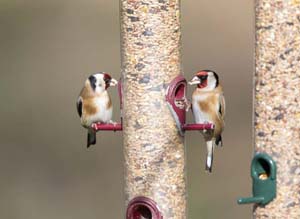"Like you, we love watching Goldfinches. You tell us that these charming birds are an increasingly familiar sight in your gardens, and we want to find out exactly what it is about our gardens that Goldfinches need.”
Why do we need a survey?
With 70% more Garden BirdWatch participants reporting Goldfinches now than 20 years ago, it’s apparent that they are far more common in our gardens than they used to be, but we don't fully understand the reasons for this. How important is the food we put out or which plants we grow? Do they truly prefer nyger seed or is sunflower seed their choice treat? We need your help to find out the answers!
Using your counts we will investigate the factors behind the increase of Goldfinches and uncover their feeding habits. Understanding how birds use the resources in our gardens means that we can provide for them when times are hard.
What can you do?
We want you to spend two minutes watching the Goldfinches in your garden, and tell us how many you see and what they are feeding on. We are also interested in how their feeding behaviour changes throughout the winter so if you regularly get Goldfinches you can help us by reporting more than once.
Find out exactly what and how to record with our instructions.
Please have a look at our FAQ page if you have any questions.
Background
The Goldfinch Feeding Survey is running between November 2015 and February 2016 inclusive. You do not need to provide bird food to take part in this survey.
This survey will support new research being undertaken by BTO Research Ecologist Kate Plummer, to investigate whether the increasing use of garden bird foods by Goldfinches is helping their national population to grow. Kate and other BTO scientists recently showed that supplementary feeding has affected the migratory behaviour of wintering Blackcaps in the UK.

